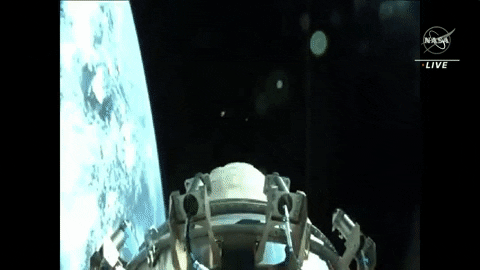4 min read

Components of a NASA technology that could one day help crew and cargo enter harsh planetary environments, like that of Mars, are taking an extended trip to space courtesy of the United States Space Force.
On Aug. 21, several pieces of webbing material, known as Zylon, which comprise the straps of the HIAD (Hypersonic Inflatable Aerodynamic Decelerator) aeroshell developed by NASA's Langley Research Center in Hampton, Virginia, launched to low Earth orbit along with other experiments aboard the Space Force's X-37B Orbital Test Vehicle. This trip will help researchers characterize how the Zylon webbing responds to long-duration exposure to the harsh vacuum of space.
The strap material on the HIAD aeroshell serves two purposes - short strap lengths hold together HIAD's inflatable rings and longer pieces help to distribute the load more evenly across the cone-shaped structure. The HIAD aeroshell technology could allow larger spacecraft to safely descend through the atmospheres of celestial bodies like Mars, Venus, and even Saturn's moon, Titan.
"We're researching how HIAD technology could help get humans to Mars. We want to look at the effects of long-term exposure to space - as if the Zylon material is going for a potential six to nine-month mission to Mars," said Robert Mosher, HIAD materials and processing lead at NASA Langley. "We want to make sure we know how to protect those structural materials in the long term."

Flying Zylon material aboard the Space Force's X-37B mission will help NASA researchers understand what kind of aging might occur to the webbing on a long space journey before it experiences the extreme environments of atmospheric entry, during which it has to retain strength at high temperatures.
Multiple samples are in small canisters on the X-37B. Mosher used two different techniques to put the strap material in the canisters. Some he tightly coiled up, others he stuffed in.
"Typically, we pack a HIAD aeroshell kind of like you pack a parachute, so they're compressed," he said. "We wanted to see if there was a difference between tightly coiled material and stuff-packed material like you would normally see on a HIAD."
Some of the canisters also include tiny temperature and humidity sensors set to collect readings at regular intervals. When the Space Force returns the samples from the X-37B flight, Mosher will compare them to a set of samples that have remained in canisters here on Earth to look for signs of degradation.

"Getting this chance to have the Zylon material exposed to space for an extended period of time will begin to give us some data on the long-term packing of a HIAD," Mosher said.
Uninflated HIAD aeroshells can be packed into small spaces within a spacecraft. This results in a decelerator that can be much larger than the diameter of its launch vehicle and can therefore land much heavier loads and deliver them to higher elevations on a planet or other celestial body.
Rigid aeroshells, the sizes of which are dictated by the diameters of their launch vehicles, typically 4.5 to 5 meters, are capable of landing well-equipped, car-sized rovers on Mars. By contrast, an inflatable HIAD, with an 18-20m diameter, could land the equivalent of a small, fully furnished ranch house with a car in the garage on Mars.
NASA's HIAD aeroshell developments build on the success of the agency's LOFTID (Low-Earth Orbit Flight Test of an Inflatable Decelerator) mission that launched on Nov. 10, 2022, resulting in valuable insights into how this technology performs under the stress of re-entering Earth's atmosphere after being exposed to space for a short time period.






